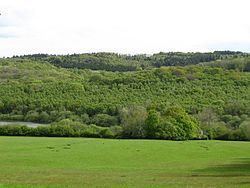Grid reference TQ710202 | Interest Biological Notification 1966 | |
 | ||
Similar Lewes Brooks, Castle Hill - Brighton, Plashett Park Wood, Fore Wood, High Woods | ||
Darwell Wood is a Site of Special Scientific Interest (biological), since 1966 in the county of East Sussex, England.
Contents
Map of Darwell Wood, United Kingdom
The site is a broadleaved woodland, with a number of streams flowing into Darwell Reservoir.
Species
Most of the wood is made-up of coppices of hornbeam (Carpinus betulus) with oak (Quercus robur) standards. Under the dense tree canopy, mosses mainly grow with a few patches of bluebells (Hyacinthoides nonscripta),also blackberry (Rubus fruticosus) and wood sorrel (Oxalis acetosella) can be found. On the higher grounds, the woodland becomes a more open, with silver birch (Betula pendula) and hazel (Corylus avellana) and some sweet chestnut (Castanea sativa) coppice areas. The ground flora of the woodland has wood sage (Teucrium scorodonia), bracken (Pteridium aquilinum) and sanicle (Sanicula europaea). On the west of the site, calcareous (chalky) soils help support an ash (Fraxinus excelsior) grow. Underplanted by moses, ramsons (Allium ursinum), bee and pyramidal orchids (Ophrys apifera) and (Anacamptis pyramidalis). The streams which pass through the site have eroded deeply into the rock layer to produce steep sided valleys. These valleys have alder (Alnus glutinosa), with local abundances of grey willow (Salix cinerea) above a ground flora of pendulous sedge (Carex pendula), water mint (Mentha aquatica), opposite-leaved golden saxifrage (Chrysosplenium oppositifolium) and ragged robin (Lychnis flos-cuculi).
